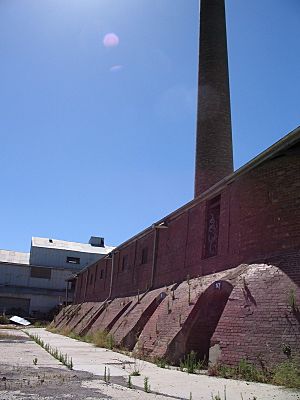Brunswick brickworks facts for kids
The Brunswick Brick Tile & Pottery Company was a very important factory that made bricks and tiles. It started in 1870 in Brunswick, Australia. It was one of the first factories in Australia to use modern machines to make bricks. People also knew it as the Hoffman Patent Brick & Tile Company, or just 'Hoffman's'. It operated for over 100 years!
Contents
Building Bricks and History
The Hoffman brickworks was started by Jenkin Collier and James McKenzie, along with Messrs Barry Owen and Rourke. They used special machines called Pratt brick presses. They also built unique ovens called Hoffman kilns. These kilns were invented by Friedreich Hoffman in Prussia in 1859.
In 1887, the company bought more advanced machines called Bradley & Craven automatic brick presses. These were made locally. The first kiln was round, but the company grew quickly. They added at least five more long Hoffman kilns between 1880 and 1914.
Growing Big and Busy
By 1884, the company opened a second factory, called No 2 works, on Dawson Street in Brunswick. This was because the first factory's clay pit had run out of clay. The new factory was huge! It employed over 400 men and made more than 40 million bricks every year. This shows how important the company was during the building boom of the 1880s.
Even after a tough economic time in the 1890s, the company kept growing. The factory had a whistle that blew every morning from 7:15 to 7:20. It was so regular that local people could set their clocks by it!
Making Pottery Too
The company also had a pottery section. A lot of the pottery they made was for terracotta sewage pipes. These pipes were used when Melbourne was building its sewage system around the year 1900. The pottery also made many things for homes, like the Mel-rose Australian Ware.
What Happened to the Site
The original Hoffman No 1 factory site was used as a rubbish dump starting in 1947. It took 17 years to fill up completely! By 1981, the land was stable enough to be turned into a park by the local council. It was named the M.W. Clifton Reserve.
The Brunswick factory was very important for two reasons. First, it brought new technology to Australia's brick-making industry. Second, it changed how brick companies did business. It led to companies buying each other and joining together. This created a group of companies that could set prices and how many bricks they would make.
In 1960, another brickmaker called Clifton Holdings took over the Brunswick brickworks. They made the factory smaller and sold off parts of it. Later, Clifton Holdings joined with another company, Nubrick, to form the Austral Brick Company. The factory kept working until the late 1990s. Then, it was sold to a developer. The plan was to save and fix part of the old factory site.
Today, parts of the site have been turned into apartments. The old brick press building is still there, but it's in very poor condition. A fire in March 2018 damaged it even more. In June 2020, its roof fell down. There are also two Hoffman Kilns that have been rebuilt into homes. A third kiln chimney remains. Some of the nearby pottery buildings have also been turned into houses.
Hoffman's Dawson Street factory is one of only two early brickworks left in Melbourne. The other is the Box Hill brickworks. The site is officially listed on the Victorian Heritage Register because of its historical importance.


